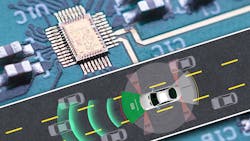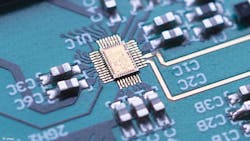Low-Power PLL Targets Short-Range Automotive/Industrial Radar Apps
This article is part of the TechXchange: Automotive Radar.
The primary goal of using radar in the automotive industry is to facilitate object detection for cars. Simple continuous-wave radar devices without frequency modulation have the disadvantage that they can’t determine target range. That’s because they lack the timing mark necessary to allow the system to accurately time the transmit and receive cycle and convert it into range.
Frequency-modulated continuous-wave (FMCW) radar differs from classical pulsed radar systems in that an electromagnetic signal is continuously transmitted. This enables time of flight of a reflecting object to be measured directly.
It’s no surprise, then, that FMCW millimeter-wave (mmWave)-based radar sensors are becoming increasingly popular. The FMCW radar emits an RF signal that’s usually swept linearly in frequency to measure both distance and velocity of moving objects. It’s achieved by continuously varying the frequency of the transmitted signal by a modulating signal at a known rate over a fixed time period.
FMCW radar systems measure the frequency difference (due to run time) between the transmitted and received echo signal for calculating the distance. They also measure the Doppler frequency (due to the Doppler effect) to calculate the speed of the object.
FMCW radars transmit a sinusoidal wave whose frequency increases linearly in time—a sweep referred to as “chirp.” In radar, a chirp is a signal in which the frequency increases (up-chirp) or decreases (down-chirp) with time. After being reflected by the object, the signal is picked up by the receiver and mixed with the original chirp signal. Subsequently, the object’s distance and speed can be extracted. The quality of the radar signal depends largely on the performance of the phase-locked loop (PLL) used to generate the chirp signal.
Charge-Pump PLL
At the recent International Solid-State Circuits Conference (ISSCC 2023) in San Francisco, imec, a Leuven, Belgium-based research center for nanoelectronics and digital technologies, presented a digitally calibrated charge-pump (CP) PLL. The PLL can generate high-quality FMCW signals for mmWave radars at low power consumption.
The PLL is a critical building block for future short-range automotive (in-cabin and out-of-cabin) and industrial radar applications. imec’s PLL generates linear chirp signals centered around 16 GHz with a chirp bandwidth of 1.5 GHz. A key achievement is reaching chirp speeds down to 12 µs, with as low as 41-kHz rms error in frequency modulation (rms-FM-error). The PLL enables extremely fast startup (below 1 µs) and minimal reset time between chirps (1-µs reset time).
Here, the chirp generator operates in duty-cycled mode—synthesizing N chirps in one burst before powering down—providing significant power savings. (N represents the number of chirps as per the configuration). According to Imec, the PLL consumes only 9.2 mW and 1.48 mW when operating in a 50% and 1% duty-cycled mode, respectively.
Even after power-down mode, the rms-FM-error of the first chirp is said to remain below 41 kHz. The duty-cycling performance was enabled by adopting a CP-based PLL architecture, fabricated in 28-nm CMOS technology and extended with a phase-offset compensation time-to-digital converter (POC-DTC) to facilitate fast self-calibration.
Potential Applications
These performance parameters make the PLL well-suited for short-range automotive radar applications ranging up to several tens of meters.
“Applications include in-cabin radar sensors to monitor presence, movements, and well-being of driver and passengers, as well as out-of-cabin sensors for parking assistance or vehicle detection,” explains Ilja Ocket, program manager at Imec.
“Our PLL also opens doors to robotics radar applications—think of on-cobot radar sensors to enhance safety and efficiency of human-robot interaction in industrial environments—as well as to radar sensors mounted on small moving objects or vehicles such as drones. At ISSCC, we are presenting a functional demo that integrates our CP-PLL with imec’s existing 140-GHz radar receiver.”
Read more articles in the TechXchange: Automotive Radar.

